There is no denying livestock production is an essential source of food and provides livelihoods for millions of people worldwide. But how we produce and consume animal products has significant environmental consequences — think deforestation, greenhouse gas emissions and excessive use of resources like land and water.
In Episode 13 of Hot Politics, host David McKie gets to the meat of a critical topic for our planet's future: sustainable livestock production.
According to a 2021 United Nations report, the livestock sector accounts for almost 15 per cent of all greenhouse gas emissions. The majority of that comes from beef and dairy cattle.
This episode looks at the challenges of transitioning to more sustainable production and making changes to our diets that won’t rob us of our favourite foods.
Sean McGrath operates a fifth-generation family ranch in Alberta. McGrath describes his methods as sustainable.
“We try to mimic the natural patterns of evolution of the landscape. So we’ll graze a portion of the ranch … and then move cattle off and allow that grass a chance to recover and regrow. It stimulates growth and helps sequester carbon in soil,” said McGrath.
Climate change policy and sustainable agriculture expert Ryan Katz-Rosene breaks down the issues with livestock production and examines the harm — and help — cattle farming presents to the ecosystem.
“There's been some studies that show that if you totally phase out the use of ruminants [like] cattle and sheep, you lose the amount of land that can be put into food production,” said Katz-Rosene.
“I think there's a lot of merit to reducing the centrality of animal foods in our diet to treating them as … special foods,” he added.
McKie also speaks with marine ecologist Ben Halpern, whose research turns around conventional thinking about the biggest greenhouse gas emitters in food production.
And lawyer and executive director of Animal Justice Camille Labchuk thinks we have to make radical changes to our diets.
“I think dietary change is one way that we can take that power back and have some degree of control over the emissions that we produce for ourselves,” Labchuck said.

Want to know more about the many elements of food production and how your diet adjustment can make a difference? Look for Hot Politics on your favourite listening app.
Hot Politics is made possible by listeners like you. If you’ve supported the podcast already, thank you. If you haven’t, click here to donate what you can to help us keep producing valuable journalism.
Got questions or comments? Email us at [email protected].
You can also follow us on Twitter @NatObserver.
Losing food production from
Losing food production from “marginal” land currently supporting ruminants would not be a problem in a rational food system.
“If everyone shifted to a plant-based diet we would reduce global land use for agriculture by 75%. This large reduction of agricultural land use would be possible thanks to a reduction in land used for grazing and a smaller need for land to grow crops.”
https://ourworldindata.org/land-use-diets
Land devoted to pasture and raising crops for animals comes with huge opportunity costs.
“If we were not using this land to grow food, it would be possible that forests and wild grasslands grow on these lands. They would not only harbour wildlife, but also store much more carbon. Meat and dairy products need more land than alternatives, and therefore have a higher opportunity cost.”
https://ourworldindata.org/carbon-opportunity-costs-food
“Reducing our consumption of farmed meat by 70%—in line with the dietary recommendations made by the EAT-Lancet Commission—would ultimately free up enough land to sequester 332 gigatons of carbon by 2050, through restored vegetation and soil. If humanity took a more drastic global step and switched to an entirely vegan diet, the sequestering potential of freed land would rise to 547 gigatons.”
https://www.anthropocenemagazine.org/2020/09/returning-pastures-to-natur...






Comments